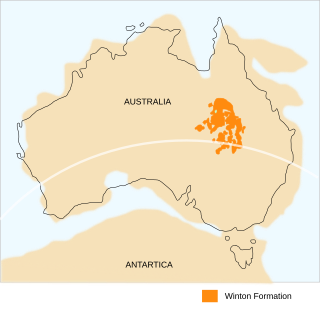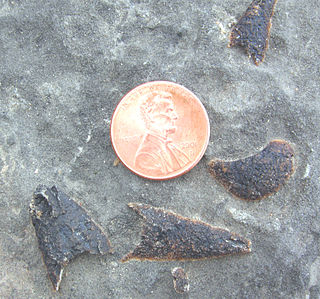
Dickinsonia is an extinct genus of basal animal that lived during the late Ediacaran period in what is now Australia, China, Russia and Ukraine. The individual Dickinsonia typically resembles a bilaterally symmetrical ribbed oval. Its affinities are presently unknown; its mode of growth is consistent with a stem-group bilaterian affinity, though some have suggested that it belongs to the fungi, or even an "extinct kingdom". The discovery of cholesterol molecules in fossils of Dickinsonia lends support to the idea that Dickinsonia was an animal.

Neoceratodus is a genus of lungfish in the family Neoceratodontidae. The extant Australian lungfish is the only surviving member of this genus, but it was formerly much more widespread, being distributed throughout Africa, Australia, and South America. Species were also much more diverse in body plan; for example, the Cretaceous species Neoceratodus africanus was a gigantic species that coexisted with Spinosaurus in what is now the Kem Kem Formation of Morocco. The earliest fossils from this genus are of Neoceratodus potkooroki from the mid Cretaceous (Albian-Cenomanian) Griman Creek Formation of Australia, remains from the Late Jurassic of Uruguay assigned to this genus probably do not belong to the genus.

Koolasuchus is an extinct genus of brachyopoid temnospondyl in the family Chigutisauridae. Fossils have been found from Victoria, Australia and date back 120 Ma to the Aptian stage of the Early Cretaceous. Koolasuchus is the youngest known temnospondyl. Koolasuchus is known from several fragments of the skull and other bones such as vertebrae, ribs, and pectoral elements. The type species Koolasuchus cleelandi was named in 1997. Koolasuchus cleelandi was adopted as the fossil emblem for the state of Victoria, Australia on 13 January 2022.

The Australosphenida are a clade of mammals, containing mammals with tribosphenic molars, known from the Jurassic to Mid-Cretaceous of Gondwana. They are thought to have acquired their tribosphenic molars independently from those of Tribosphenida. Fossils of australosphenidans have been found from the Jurassic of Madagascar and Argentina, and Cretaceous of Australia and Argentina. Monotremes have also been considered a part of this group in some studies, but this is disputed.

Meiolaniidae is an extinct family of large, probably herbivorous stem-group turtles with heavily armored heads and tails known from South America and Australasia. Though once believed to be cryptodires, they are not closely related to any living species of turtle, and lie outside crown group Testudines, having diverged from them around the Middle Jurassic. They are best known from the last surviving genus, Meiolania, which lived in the rain forests of Australia from the Miocene until the Pleistocene, and insular species that lived on Lord Howe Island and New Caledonia during the Pleistocene and possibly the Holocene for the latter. Meiolaniids are part of the broader grouping of Meiolaniformes, which contains more primitive turtles species lacking the distinctive morphology of meiolaniids, known from the Early Cretaceous-Paleocene of South America and Australia.

The Winton Formation is a Cretaceous geological formation in central-western Queensland, Australia. It is late Albian to early Turonian in age. The formation blankets large areas of central-western Queensland. It consists of sedimentary rocks such as sandstone, siltstone and claystone. The sediments that make up these rocks represent the remnants of the river plains that filled the basin left by the Eromanga Sea - an inland sea that covered large parts of Queensland and central Australia at least four times during the Early Cretaceous. Great meandering rivers, forest pools and swamps, creeks, lakes and coastal estuaries all left behind different types of sediment.

Nototherium is an extinct genus of diprotodontid marsupial from Australia and New Guinea. This mammal had hypsodont molars and weighed around 500kg. It was a relative of the larger Diprotodon and a distant kin to modern wombats.

Cherninia is an extinct genus of mastodonsaurid temnospondyl. The type species, Cherninia denwai, is known from the Denwa Formation of India. It is based on a massive skull, ISI A 54, which was originally considered a species of Parotosuchus in 1998 before being given its own genus in 2001.

The Wonthaggi Formation is an informal geological formation in Victoria, Australia whose strata date back to the Early Cretaceous. It is part of the Strzelecki Group within the Gippsland Basin. Dinosaur remains are among the fossils that have been recovered from the formation. It is partially equivalent to the Eumeralla Formation.
Anthoceras is a genus of straight, annulated, proterocamerioceratids from the Lower Ordovician, found in North America, NW Australia, and Siberia. The cross section is circular, the siphuncle moderately large, and marginal. Segments are constricted ; septal necks hemichoantici to subholochoantic ; connecting rings thick. Endocones are long and slightly asymmetric.
Warendja is an extinct genus of marsupial, present from the Late Miocene to the Late Pleistocene, which went extinct in the Quaternary extinction event. Weighing 10 kg, Warendja is the earliest known vombatiforme to exhibit hypsodonty.
Plagiobatrachus is an extinct genus of plagiosaurid temnospondyl. It is known from the Rewan Formation, an Early Triassic formation in Australia.

Matthevia is a genus of Cambrian molluscs, perhaps related to the chitons. It consists of repeated monoplacophoran-like shells; according to one hypothesis, chitons arose when these tall shells began to overlap over the generations. The tall element of the shell was retained and forms the tips of modern chiton plates. There are distinct head, 'centre', and tail valves, which occur approximately in the ratio 1:5:1 — suggesting a seven-plated configuration.
Stenothecidae is an extinct family of fossil univalved Cambrian molluscs which may be either gastropods or monoplacophorans.
The Molecap Greensand is a Late Cretaceous geologic formation, located in the state of Western Australia in Australia.

Cavenderichthys talbragarensis is a species of prehistoric bony fish found in the Talbragar Fish beds. Recently, it has been placed as a member of Orthogonikleithridae, alongside Leptolepides, Orthogonikleithrus and Waldmanichthys.

The Talbragar fossil site is a paleontological site of Late Jurassic (Tithonian) age in the central west of New South Wales, Australia. It lies about 30 kilometres (19 mi) north-east of the town of Gulgong, and 300 kilometres (190 mi) north-west of Sydney. The site has been known for over a century during which it has been extensively excavated to the point of near exhaustion. It is now registered as a Crown Land Reserve for the preservation of fossils; access is by permit, and the collection of rocks and fossil specimens is prohibited. The 4-hectare (9.9-acre) reserve is listed on the Register of the National Estate.
Namilamadeta is an extinct genus of herbivorous marsupial from Australia that was around the size of a dog.

Errolosteus goodradigbeensis is an extinct buchanosteid arthrodire placoderm. Its fossils have been found in Emsian-aged marine strata of New South Wales, Australia.
The Takatika Grit is a geologic formation in Chatham Islands, New Zealand. It preserves fossils dating back to the Paleocene period, although it also preserves disturbed and re-worked Maastrichtian and Campanian microfossils and tetrapod fossils. A 2017 study found that it dated to late Early to Mid Paleocene on the basis of dinoflagellates. It has been subdivided into two informal units, a lower phosphatic unit containing bones and nodular phosphatic layers, and an upper unit with abundant sponge remains and siliceous microfossils.













